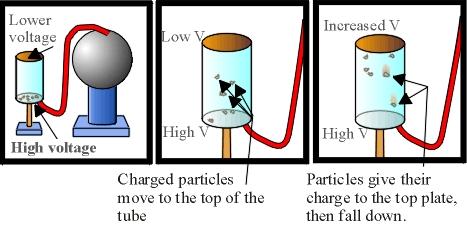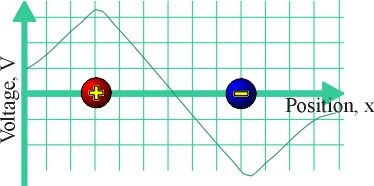The Van de Graaf makes some Vermiculite dance like crazy!
WATCH VIDEO
Teachable Topics:
- Charged particles
- Van de Graaff Generator
- Electric potential
|
Theory: Every point around a charged object (such as a Van de Graaf generator's dome) has an electric potential, V. The potential near a positively charged Van de Graaf (VDG) machine is positive, while the potential far away from it is lower. The potential near a negatively charged object is negative, and thus lower still.
|
Figure 1: Electric potential over a distance |
A particle with charge +q brought near the (positively charged) VDG tends to move to the position where V is the lowest. This is another way of saying that the particle is repelled from the VDG.
In the "Volta's Hailstorm" demo, a plastic tube is enclosed on either end by metal plates, and the bottom end is electrically attached to the VDG. Within the tube are some vermiculite chips. When the VDG is turned on, the bottom becomes positively charged (thus giving it a high electric potential). The metal bottom of the tube transfers positive electric charge to the vermiculite particles. These then tend to move to the uncharged top of the tube, where the potential is lower. As the particles hit the top of the tube, they transfer their positive charge to it. After transferring their charge, the now-neutral particles fall to the bottom of the tube.

Eventually so much charge is imparted to the metal top that is has the same electric potential as the bottom. Consequently, the particles stop rising up.
If something happens to remove the positive charge from the top of the tube, it becomes electrically neutral. This can be accomplished by connecting a grounded wire to the top of the tube. With the top of the tube grounded, charged particles flee the high-potential bottom of the tube and give their charge to the top. The particles are neutralized and quickly fall to the bottom of the tube again, where the whole process repeats again and again. This creates the "hailstorm" seen in the videos.
Apparatus:
- Van de Graaf
- Grounding rod
- Vermiculite particles in a "Volta's Hailstorm" Tube
Procedure:
|
Figure 2: Apparatus |
SAFETY WARNINGS:
- A Van de Graaff can produce a lot of charge! Touch the Van der Graff and Volta's Hailstorm tube only with the grounding rod.
- The demo seems to work best when the tube is far away from the Van de Graaf.





